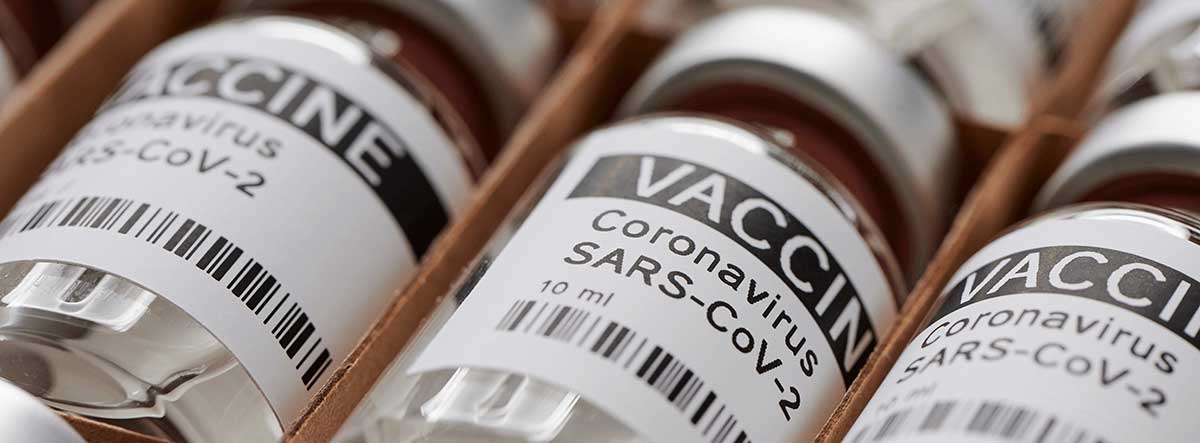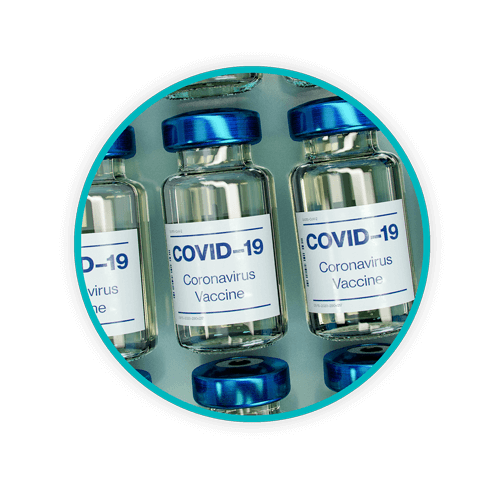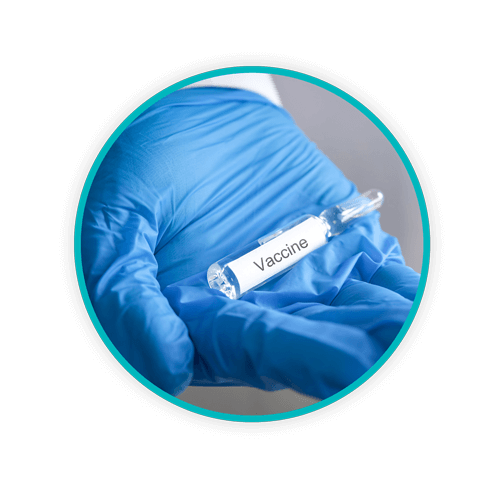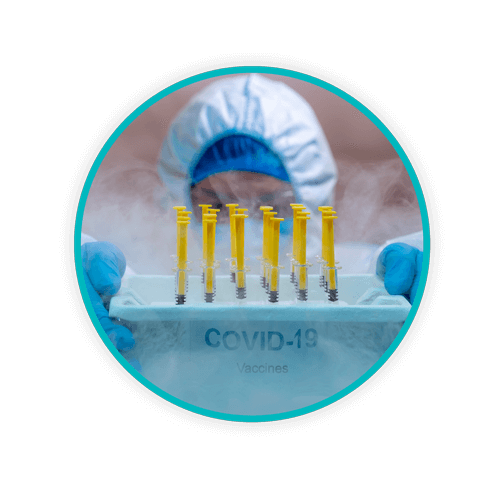COVID-19 Vaccine Waste Disposal Guidelines

This article was updated on Feb. 11, 2022.
The waste disposal of Coronavirus vaccines is a new waste consideration for many hospitals and COVID-19 pop up vaccination sites around the country. To support our customers with up-to-date instruction and resources on the disposal of empty vials and syringes or partially used vaccines, we have consolidated our expertize into this breakdown of COVID-19 waste management and supportive resources to ensure your staff are protected, and you have confidence in waste disposal compliance.
TOPICS WE WILL COVER:
2 / COVID-19 Waste Regulations
3 / COVID-19 Waste Disposal Guidance
4 / COVID-19 Vaccine Equipment and Disposal
5 / Dry Ice Disposal Guidelines
COVID-19 Waste Updates
As of 2022, Covid-19 vaccine disposal and waste regulations have remained relatively unchanged, and guidelines provided by the Centers for Disease Control and Prevention (CDC) continue to recommend that such waste is disposed of “in accordance with local regulations” and in compliance to processes currently utilized for regulated waste disposal.1 These guidelines apply to the most prevalent vaccines produced by Pfizer, Moderna, and Janssen (J&J) and others.
As of late August 2021, the CDC noted that over 538 million people had been vaccinated. Approximately 212 million are now considered “fully” vaccinated – first and second jab for Pfizer or Moderna and the one-shot J&J plus boosters. Those who are just receiving their first “jabs” and those who have received boosters from one of the three major vaccines (Moderna, Pfizer, and J&J) have reached the 87 million mark and continues to climb.
Processes for delivery of vaccines has primarily transitioned from mass vaccination sites to local pharmacies, physician’s offices, and public health departments. Waste management protocols initiated through the worst of the pandemic still apply for vaccine waste.
That said, the surge in use of home-based Covid-19 testing kits and the continued use of millions of protective masks and gloves during the Delta and Omicron waves of the virus has increased. In addition to Covid-19 variant testing kits used by professional healthcare providers, pharmacies, and the general public, waste disposal in home-based scenarios must also be taken into consideration.
Clinical Point-of-Care Covid-19 Testing Sites
With the “original” Covid-19 and waves of variants as well as future mutations, testing sites are not likely to disappear anytime soon.
According to the CDC, point-of-care and laboratory professionals are to treat all waste (including kit components) from suspected or confirmed Covid-19-exposed patients as biohazardous waste, and that goes for the testing swabs as well. Testing kits used to determine exposure to any variant of Covid-19 mutations of the virus are treated as “potentially infectious materials.” Follow standard precautions of federal and state-by-state guidelines for handling and disposal.
The collection of specimens and performance of rapid-testing for facilities comes with some regulatory requirements. Maintaining recommended distancing for proper infection control, use of personal protective equipment (PPE), and use of N95 or higher level respirators are also recommended. 2
All facilities providing testing should refer to local county as well as state Departments of Health and follow all local, state, and federal regulations regarding biohazardous or infectious waste disposal practices. Reference can also be made to the Environmental Protection Agency Regulations and State Universal Waste programs in the United States.
What about Home-Based Use of Covid-19 Testing Kits?
Throughout the US, states and their counties may have different recommendations for disposal of at-home Covid-19 testing kits. However, the CDC states that at-home test kits are not considered biohazard waste and can be thrown into normal household trash. Most states do not regulate household waste and currently have no specific guidelines for the disposal of home-based Covid-19 tests, regardless of variant. That means test cards, nasal swabs, and test solutions can be disposed of in household trash.
The CDC recommends following local protocols, which can be found through county and state Public Health departments.
COVID-19 Waste Regulations 
The Occupational Safety and Health Administration (OSHA) regulates the handling of sharps, and states regulate their final disposal.
OSHA requires that when an immunization is being administered, a sharps container must be located as close as possible to the point of use.
COVID-19 Waste Disposal Guidance
All COVID-19 vaccines (Pfizer, Moderna, Johnson/Johnson) are preservative free and classified as non-hazardous medication if not empty or completely administered, however, empty pre-filled syringes, even safety syringes, are considered sharps waste.
Here is a quick breakdown of how all Coronavirus vaccine associated waste should be handled:
- Syringes. Used syringes (whether full, empty or partially empty), must be disposed of in an industry approved sharps container and disposed of as regulated medical waste
- Empty Vials. The Department of Defense has recommended that all coronavirus vaccine vials should be captured in an approved sharps container to mitigate unauthorized use or diversion.
- Full or Non-Empty Vials. Containing a non-hazardous medication (per above description), non-empty vials should be disposed of in a non-hazardous pharmaceutical container
- Medical Waste. Any non-sharp items used in the administering of vaccines such as gloves, gauze, bandages or cotton balls do not belong in a sharps container. If these items are considered potentially infectious, they should be disposed of in RMW containers
- Vaccine Packaging. Providing the packaging is “empty”, this can be disposed of as regulated medical waste. please revert to the instructions provided by your vaccine manufacturer
How to dispose of COVID-19 vaccine waste if:

* Always check state regulations when disposing of a sharp
NOTE: Never detach needles from the syringe. While having unused vials of vaccine is not the optimal situation, but disposal of them is necessary, follow the guidance of the manufacturer, the FDA and your state regulation, including your organization’s established policies. Alternatively, reach out to your medical waste disposal provider regarding the best option.

COVID-19 Vaccine and Equipment Disposal
Note: Sometimes unused vaccine and diluent doses, unopened vials, expired vials, and potentially compromised vaccine may be returned for credit, even if they must be discarded. Contact the state or local immunization program or the vaccine manufacturer for vaccine-specific information.
Open and broken vials and syringes, manufacturer-filled syringes that have been activated, and vaccines pre-drawn by providers cannot be returned and should be discarded according to state requirements.
Dry Ice Disposal Guidelines
With dry ice being used in the transportation and preservation of COVID-19 vaccines across the country, we want to ensure you are aware of how to safely dispose of dry ice. 
Dry ice changes directly into the gaseous form, it does not “melt” but it sublimates. It takes about 24 hours for a block of dry ice to sublimate completely. Let it sublimate at room temperature in its styrofoam shipping container in an area that is amply ventilated. It is important that no staff are nearby for this process as dry ice is basically compressed carbon dioxide. Do not leave dry ice in unsecured areas. Dry ice in an enclosed space can lead to build-up of carbon dioxide which can result in a potential for suffocation. After the dry ice has sublimated entirely, you must dispose of the container as well as the gloves that were used during the process.
PPE and Tips for Safe Handling and Disposal of Dry Ice
- Wear appropriate eye protection, including goggles and/or a face shield, as well as a laboratory coat
- Use tongs to handle dry ice when possible
- Use loose-fitting, thermally insulated gloves to manually handle dry ice
- Nitrile exam gloves will not provide enough protection
- Never handle dry ice with bare hands
For more information about how to correctly and safely dispose of your Coronavirus vaccine sharps, vials or medical waste, reach out to one of our clinical experts for guidance
Photo attributed to Daniel Schludi
Let's Talk!
Your time is valuable, and we don’t want to play hard to get. You can either phone us directly on the details listed on our contact page, or feel free to fill out this short form and one of our team members will get back to you as quickly as possible.
